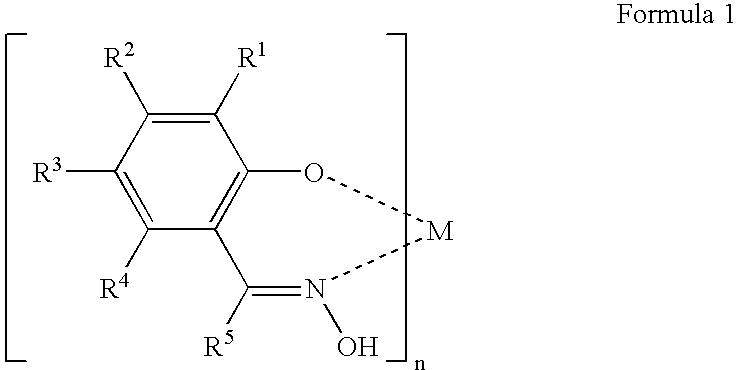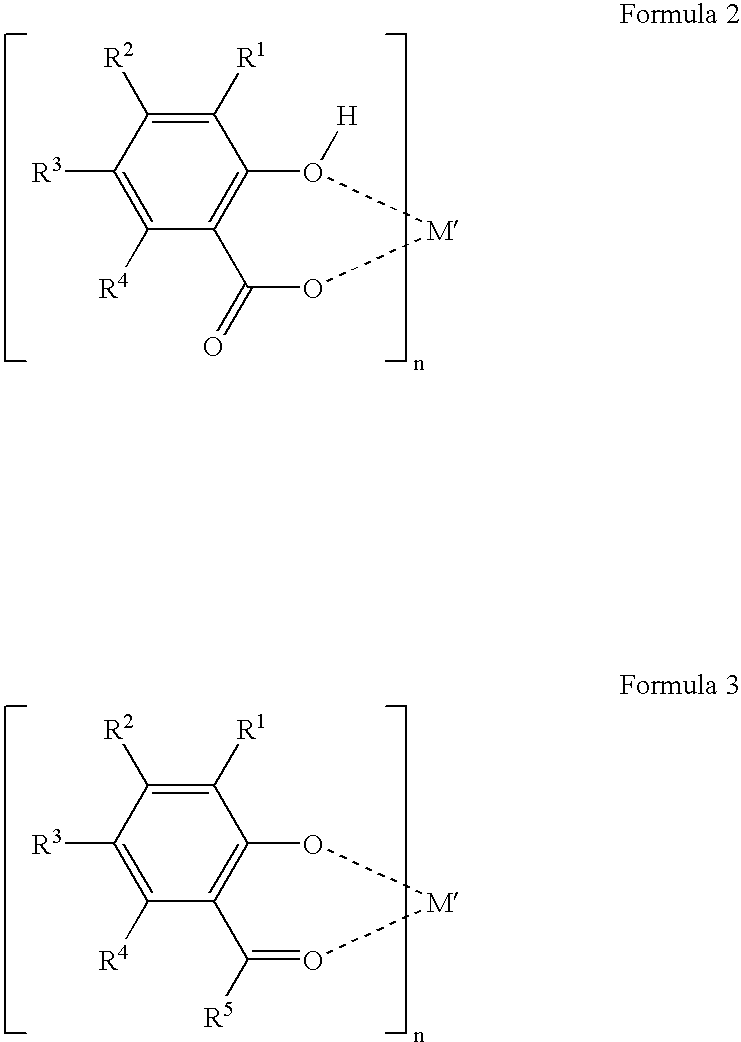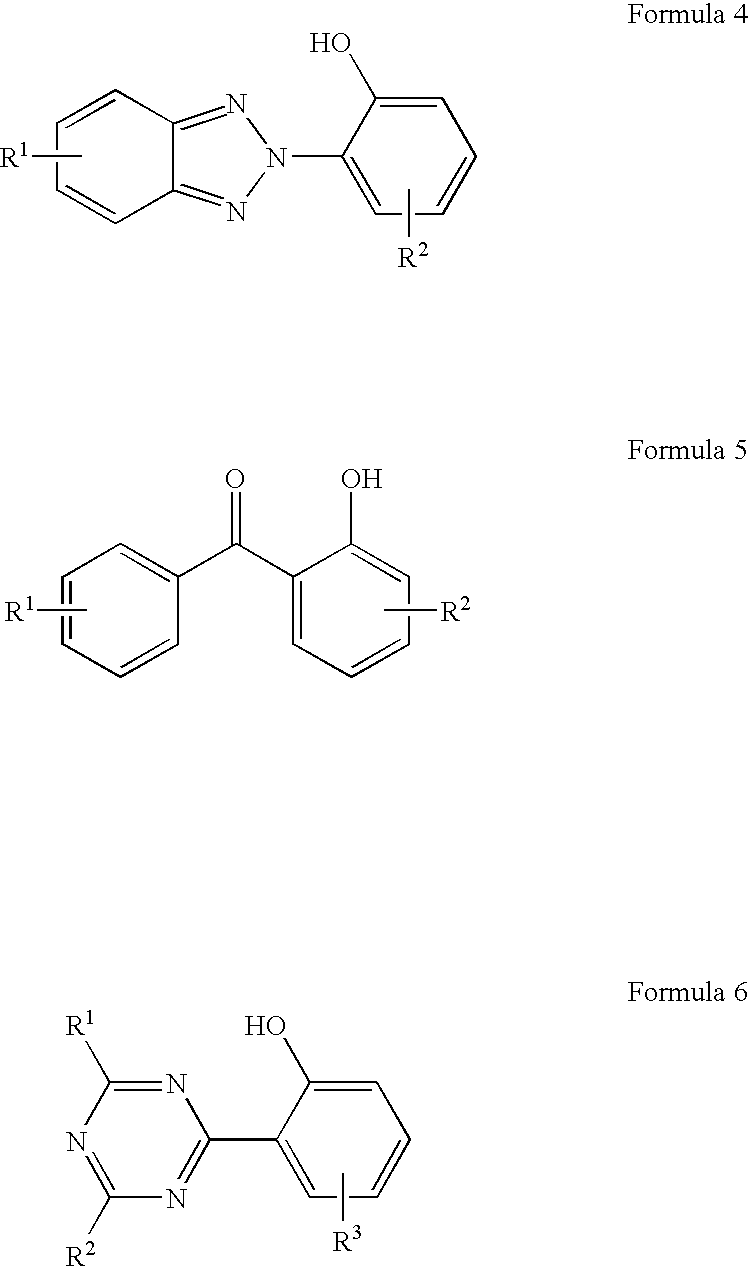Fluorinated dye stabilizers in fluorinated dielectric solvent
a technology of dye stabilizer and dielectric solvent, which is applied in the field of compound compounds, can solve the problems of dye or colorant color fade, and the quenching efficiency and solubility of most quenching agents are not soluble in halogenated dielectric solvents, and achieves the effect of improving dye fastness and high quenching efficiency and solubility
- Summary
- Abstract
- Description
- Claims
- Application Information
AI Technical Summary
Benefits of technology
Problems solved by technology
Method used
Image
Examples
preparation 1
Synthesis of Rf-amine
[0134]
[0135]17.8 Grams of Krytox® methyl ester (DuPont, MW=about 1780, g=about 10) was dissolved in a solvent mixture containing 12 g of 1,1,2-trichlorotrifluoroethane (Aldrich) and 1.5 g of α,α,α-trifluorotoluene (Aldrich). The resultant solution was added drop by drop into a solution containing 7.3 g of tris(2-aminoethyl)amine (Aldrich) in 25 g of α,α,α-trifluorotoluene and 30 g of 1,1,2-trichlorotrifluoroethane over 2 hours with stirring at room temperature. The mixture was then stirred for another 8 hours to allow the reaction to complete. The IR spectrum of the crude product clearly indicated the disappearance of C═O vibration for methyl ester at 1780 cm−1 and the appearance of C═O vibration for the amide product at 1695 cm−1. Solvents were removed by rotary evaporation followed by vacuum stripping at 100° C. for 4–6 hours. The crude product was then dissolved in 50 mL of PFS2 solvent (perfluoropolyether from Solvay Solexis) and extracted with 20 mL of ethy...
preparation 2
Synthesis of a Fluorinated Silicon Phthalocyanine
The Structure of SiPc-1:
[0137]
[0138]
A. Synthesis of Compound A, SiPc(OSi(CH3)2(CH2)2(CF2)7CF3)2
[0139]As shown in Scheme A, a mixture of (heptdecafluoro-1,1,2,2-tetrahydrodecyl)dimethylchlorosilane (2.50 g, 4.63 mmol, Gelest) and a suspension of SiPc(OH)2 (1.00 g, 1.74 mmol, Aldrich) and pyridine (140 mL, Fisher Scientific), where each had been dried by distillation (˜10 mL of distillate), was slowly distilled for 5 hours (˜55 mL distillate). The resulting dark blue solution was evaporated to dryness by rotary evaporation (60° C.) under pump vacuum (1 Torr). The solid obtained was washed with an EtOH—H2O mixture (1:1, 50 mL) and removed by filtration, dried (60° C., 60 Torr), dissolved in CH2Cl2 (120 mL) and filtered. The filtrate was evaporated to dryness by rotary evaporation (60° C.) under pump vacuum (1 Torr). A blue solid (2.26 g, 82% based on SiPc(OH)2) was obtained.
B. The Synthesis of SiPc-1
[0140]A mixture of sodium dithionite ...
preparation 3
Synthesis of a Fluorinated Cu Phthalocyanine Dye
The Structure of CuPc-1
[0141]
[0142]
[0143]A fluorinated Cu phthalocyanine dye, CuPc-1, was prepared according to U.S. Pat. No. 3,281,426 (Scheme B). A mixture of copper phthalocyanine (41.0 g, 71.2 mmole, Aldrich) and 1-iodoperfluorooctane (370 g, 678 mmole, SynQuest) was added into a 1-gallon pressure reactor (Parr Instrument Co.) with a glass liner. The reactor was vacuum sealed at 1 Torr and heated at 375° C. for 3 days. The crude product obtained was mixed with 200 g of Celite (Fisher Scientific) and extracted with 4 L of PFS-2™ in Soxhlet extractor for 5 days. The dark blue solution obtained was washed with 4 L of acetone 3 times and evaporated to dryness by rotary evaporation (60° C.) under vacuum (˜5 Torr). A dark blue solid, CuPc-1, was obtained (106 g, 66% yield).
PUM
| Property | Measurement | Unit |
|---|---|---|
| dielectric constant | aaaaa | aaaaa |
| dielectric constant | aaaaa | aaaaa |
| temperature | aaaaa | aaaaa |
Abstract
Description
Claims
Application Information
 Login to View More
Login to View More - R&D
- Intellectual Property
- Life Sciences
- Materials
- Tech Scout
- Unparalleled Data Quality
- Higher Quality Content
- 60% Fewer Hallucinations
Browse by: Latest US Patents, China's latest patents, Technical Efficacy Thesaurus, Application Domain, Technology Topic, Popular Technical Reports.
© 2025 PatSnap. All rights reserved.Legal|Privacy policy|Modern Slavery Act Transparency Statement|Sitemap|About US| Contact US: help@patsnap.com



